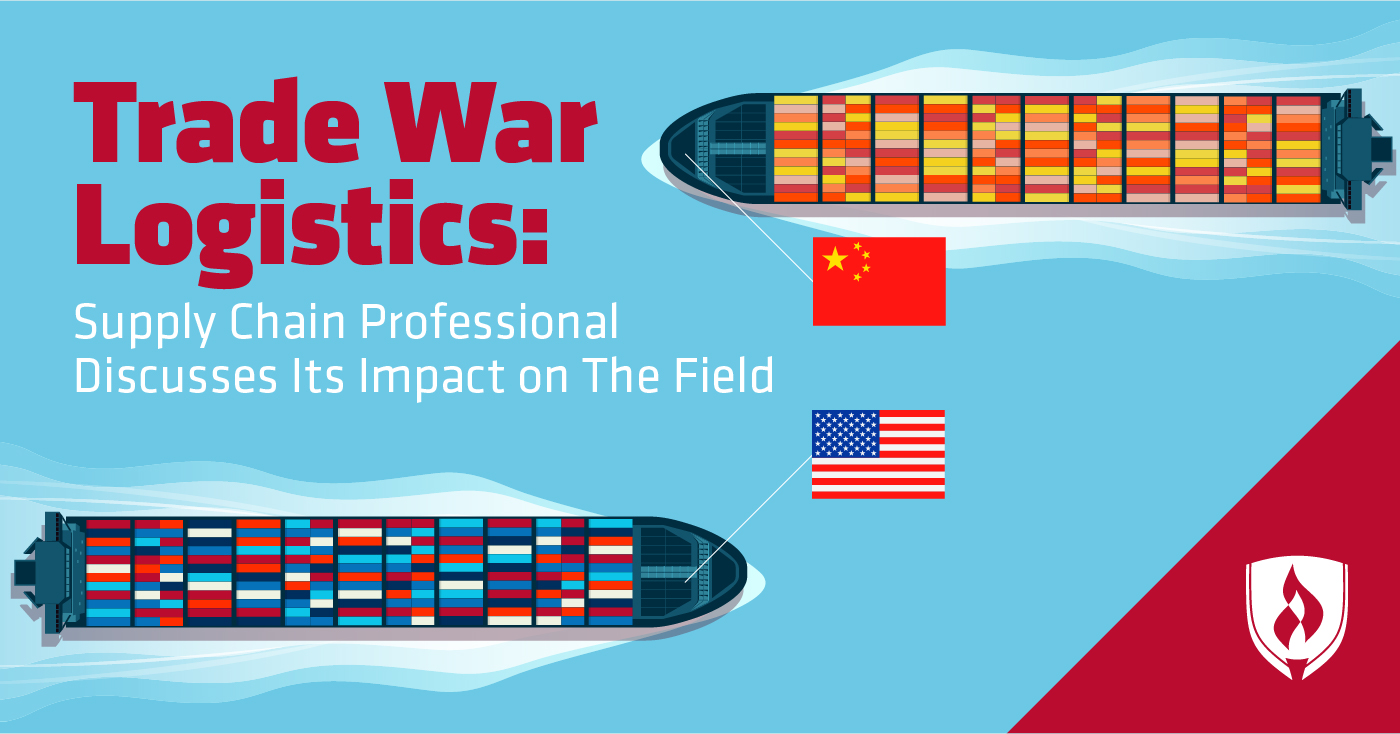Trade War Logistics: Supply Chain Professional Discusses Its Impact on the Field
By Brianna Flavin on 12/02/2019

Supply chain logistics is a typically under-the-radar yet fascinating industry. Most of us rely on the goods and parts that supply chains bring to our doors, our companies, our grocery stores—but few of us pay close attention to the inner workings of this industry.
Whether the general public is paying attention or not, big changes in the supply chain also spell change for society at large. It could mean goods that come from new places, products we can no longer buy, changes in commercial prices or more. Given the global nature of many supply chains, you might be wondering what happens in this field in the event of an escalating trade war?
You’ve probably seen more than a few headlines covering the tit-for-tat posturing and trade negotiations revolving around the U.S. government and other foreign countries. The most notable includes an announced tariff increase on $300 billion worth of Chinese goods.1 It’s reasonable to think that those tariff increases will have a pricing ripple effect—impacting everyone in the supply chain until they land at the consumer’s front door. But the potential price adjustments consumers face is only one factor in a long list of factors that supply chain professionals are balancing.
How have the recent U.S. tariff escalations with China (and other countries) affected the work of supply chain and logistics professionals? What will trade war logistics mean for the supply chain as a whole? To get some insight into this crucial industry, we asked a logistics expert to shed some light on what’s happening under the surface.
What challenges do logistics managers face in a potential trade war?
“The hardest challenge is the unknown,” says Joe Lazzerini, senior analyst at Source One. “The trade negotiations take place up until the 11th hour regardless of the outcome—so even if a company is braced for the tariff to go into effect, there is always a chance no change is needed, with an agreement signed at the last minute.”
This means that supply chain pros have to prepare for multiple outcomes, sometimes on a tenuous timeline. For example, Lazzerini says the main concerns with a new tariff are network-wide shifts and concerns with importing. “There are only so many container ships moving freight out of southeast Asia,” Lazzerini says.
“So if the volume dries up in the primary ports in China but doubles or triples in Malaysia, Vietnam and North Korea, what will the cost and time impact be? How can you help prevent a disruption to the supply chain?” Lazzerini explains that logisticians might have to negotiate and settle for a smaller amount of space on a container ship, which could increase pricing and also delay freight.
Another likely fallout of a pending tariff is the mad rush for companies to get their freight out of China before the tariff actually hits. “This creates a log jam at the port and creates a bidding war for space on a container ship. If you are one of the lucky companies who is able to empty your supply in China before the tariff, the bottleneck at the U.S. west coast ports becomes an issue.”
Lazzerini says the problems with space and volume only amplify after that, with low storage space in the U.S. and the likely chance that even if you got your freight out of China, the larger volume would be so expensive to store on U.S. soil that it could potentially cancel out the cost-saving measure of avoiding the tariff in the first place.
Logistics management is already a role with so many moving parts—trying to calculate the best scenario when changes ripple through the system is a puzzling, ‘falling-dominoes’ affair.
So wait, what does a logistics manager do?
You’re probably getting the vibe that logistics involves lots of puzzle-solving—and in a sense you’re right! These professionals are in charge of making sure a company’s supplies, equipment and/or goods get to their necessary destinations intact and on time.
Logistics managers (also called logisticians or supply chain managers) analyze and coordinate an organization’s supply chain—the system that moves a product from supplier to consumer, according to the Bureau of Labor Statistics (BLS).2 They manage the entire life cycle of a product, which includes how a product is acquired, preserved and delivered.
The work tends to be fast-paced, the BLS notes, with logistical problems that can occur at any point in the chain.1 Logisticians need to stay on their toes to troubleshoot any issues that arise—an escalating trade war, for example.
But Lazzerini points out that supply chain management isn’t just about balancing numbers. “Making sure the correct partnerships are in place to move product(s) throughout the supply chain network can be more important than figuring out a way to save a few dollars. The potential impact on production, vendors, clients and other partners can be quite detrimental if cost is the only driver in decision-making for logistics providers.”
To get a little more information on the field of logistics, check out: What Is Logistics Management? Understanding Its Importance.
What can logisticians do in a trade war?
As the whole supply chain reverberates in response to changes in trade, logisticians get creative.
Lazzerini says that supply chain processes and procedures may become stagnant, all too often because it’s the way things have been done for a long time. “Re-evaluating the supply chain and looking to alternative ways to bring in goods can benefit you in the long run.”
When you are looking at the drawing board again, Lazzerini says you might find opportunity to reduce costs and make alternative choices that are smarter and more beneficial—if you are proactive enough to find them before you have to scramble against a deadline.
What could trade war logistics mean for the future of the industry?
“There has already been a shift in where companies are importing from,” Lazzerini says. “Businesses are electing to move their suppliers away from China and into other nearby countries like Vietnam. If a company decides to remain importing from China, they are then passing the added expenses onto their consumers either in the end cost of a product or in the domestic shipping cost.”
The uncertainty in trade negotiations has also added much more pressure on logistics and supply chain professionals to do as much alternate approach research as possible, Lazzerini says. Everyone is trying to ensure they have a contingency plan in place if more tariffs take hold.
Bewildered or fascinated?
As you can see, supply chain logistics can be a challenging field with plenty of potential curveballs thrown your way. It takes excellent analytical skills, negotiating ability and the ability to stay cool under pressure. But for the right people, logistics is the exciting dream career they didn’t even know to dream about. If you’re the type of person who loves to roll up your sleeves and tackle complex logistical problems, this might be the right field for you.
If getting a closer look at life as a logistician interests you, check out our article, “6 Things I Wish I Knew Before Starting a Supply Chain Management Career.”
Related Articles:
1New York Times, Trump Says He Will Raise Existing Tariffs on Chinese Goods to 30%, [accessed October 2019] https://www.nytimes.com/2019/08/23/business/china-tariffs-trump.html
2Bureau of Labor Statistics, U.S. Department of Labor, Occupational Outlook Handbook, [accessed October, 2019] www.bls.gov/ooh/. Information represents national, averaged data for the occupations listed and includes workers at all levels of education and experience. Employment conditions in your area may vary.




